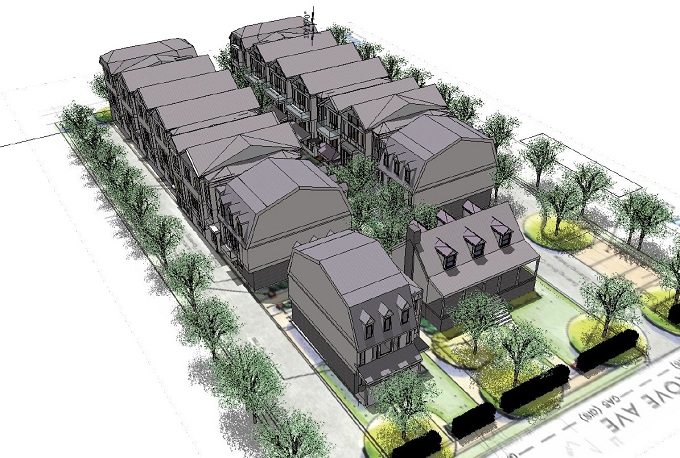
A rendering shows the 14 townhomes and new detached home planned beside the existing 1½-story house, pictured at lower right. (City documents)
A stretch of Grove Avenue in Richmond’s West End is becoming a hotspot for residential infill developments, as a prolific area homebuilder is planning 15 new homes a block away from two projects that would add nearly as many homes.
Center Creek Homes is proposing 14 townhomes and one detached home beside the centuries-old house at 3923 Grove Ave., a 0.8-acre lot beside the Malvern Manor apartments two blocks west of the Interstate 195 expressway.
The existing house, which reportedly dates to the late 1700s, would be retained with the development, according to plans filed with the city last week. The new detached house would be built beside it, and the townhomes would fill the backyard in two rows of seven units with a courtyard between them.
The homes would be accessed via two roads off Grove that would extend to but not connect with Sterling and Lafayette streets to the rear of the site. Ground-level garages would provide parking for the townhomes, while the new detached home would have one surface space. Five additional surface spaces would be included near the existing house.
All of the new homes would be three stories and feature varying facades, according to the plans. The homes would feature “modern and open” floorplans ranging from two to four bedrooms and 2½ to 3½ bathrooms. The homes also would include porches and balconies, and landscaping and tree plantings would provide visual buffers for the homes.
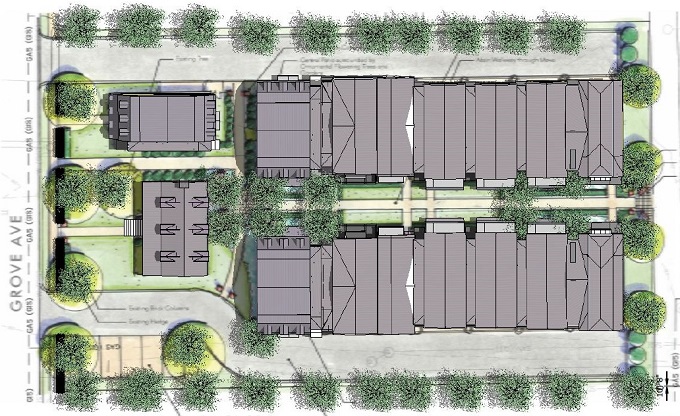
A site plan shows the detached homes fronting Grove and the townhomes in seven-unit rows behind them.
Total square-footages for the homes are not specified on the plans. The three-story units would be built on lots ranging from about 600 to 1,000 square feet in size.
Center Creek is seeking a special-use permit from the city to allow the townhomes on the site, which is zoned to allow detached homes but not attached homes. The new detached home could be built “by right,” according to the application submitted for Center Creek by local consulting firm Baker Development Resources.
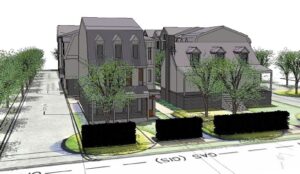
The new homes would all be three stories in height. The existing home would be retained with the development.
The project was presented to neighbors in a meeting in recent weeks. CEO Dan Magder, who leads Center Creek with COO and architect Greg Shron, declined to discuss the project while the city is reviewing their SUP application but provided a statement with Shron in an email.
“We’ve been focused over the past several months on incorporating feedback we’ve received from City planners, neighbors and local advocacy groups into our design, and plan to continue working with all stakeholders on a successful project that will bring more housing options to the Near West End,” their statement said.
“Our goal at Center Creek Homes is to design high-quality infill houses in a thoughtful manner that fit into the specific fabric of their particular neighborhood.”
Backed by Magder’s Center Creek Capital Group, a real estate-focused private equity firm based in D.C., Center Creek Homes launched in Richmond in 2018 and has since amassed a wide-ranging portfolio of one-off infill homes and cluster developments.
The company’s current projects include eight townhomes in the works on Cary Street in the Fan, and a rare infill on Arthur Ashe Boulevard involving two homes across from the Virginia Museum of History & Culture.
It’s working on the Grove Avenue project with C2 The Creative Collaborative, a consulting firm based in Beaufort, South Carolina.
An LLC tied to Center Creek Homes purchased the Grove property in May from a trustee for previous owner John Thomas Jr. Property records show it paid $1.8 million for the property, which the city has assessed at $1.06 million.
The city property record lists the 1½-story house as having been built in 1775. An R-Home Magazine article from 2012 goes into more of the property’s history.
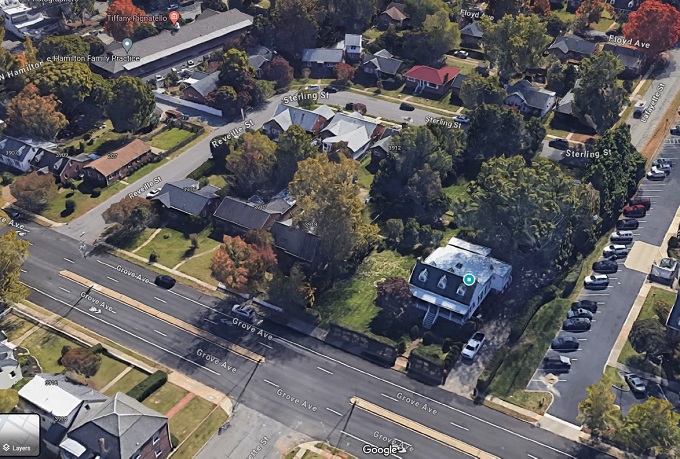
A Google Maps aerial view included in the plans shows the existing house and undeveloped site behind it.
The property is across Grove a block west from the site of another infill development that’s currently underway: the six-unit, three-story Grove at Hamilton townhomes that Vertical Builders is constructing at Grove and Hamilton Street.
Behind that site, local developers Jeremy Connell and Julie and Paul Weissend recently filed plans for an eight-home infill at 3801-03 Hanover Ave. The three-story townhomes would similarly fill the backyards of two existing houses there.
The area is surrounded by established single-family neighborhoods and includes Malvern Manor, several offices and churches and the Mount Vernon Condominiums that line I-195. It’s also across the expressway from the highly visible construction for Flournoy Development Group’s six-story apartment building at Grove and Thompson Street.

A rendering shows the 14 townhomes and new detached home planned beside the existing 1½-story house, pictured at lower right. (City documents)
A stretch of Grove Avenue in Richmond’s West End is becoming a hotspot for residential infill developments, as a prolific area homebuilder is planning 15 new homes a block away from two projects that would add nearly as many homes.
Center Creek Homes is proposing 14 townhomes and one detached home beside the centuries-old house at 3923 Grove Ave., a 0.8-acre lot beside the Malvern Manor apartments two blocks west of the Interstate 195 expressway.
The existing house, which reportedly dates to the late 1700s, would be retained with the development, according to plans filed with the city last week. The new detached house would be built beside it, and the townhomes would fill the backyard in two rows of seven units with a courtyard between them.
The homes would be accessed via two roads off Grove that would extend to but not connect with Sterling and Lafayette streets to the rear of the site. Ground-level garages would provide parking for the townhomes, while the new detached home would have one surface space. Five additional surface spaces would be included near the existing house.
All of the new homes would be three stories and feature varying facades, according to the plans. The homes would feature “modern and open” floorplans ranging from two to four bedrooms and 2½ to 3½ bathrooms. The homes also would include porches and balconies, and landscaping and tree plantings would provide visual buffers for the homes.

A site plan shows the detached homes fronting Grove and the townhomes in seven-unit rows behind them.
Total square-footages for the homes are not specified on the plans. The three-story units would be built on lots ranging from about 600 to 1,000 square feet in size.
Center Creek is seeking a special-use permit from the city to allow the townhomes on the site, which is zoned to allow detached homes but not attached homes. The new detached home could be built “by right,” according to the application submitted for Center Creek by local consulting firm Baker Development Resources.

The new homes would all be three stories in height. The existing home would be retained with the development.
The project was presented to neighbors in a meeting in recent weeks. CEO Dan Magder, who leads Center Creek with COO and architect Greg Shron, declined to discuss the project while the city is reviewing their SUP application but provided a statement with Shron in an email.
“We’ve been focused over the past several months on incorporating feedback we’ve received from City planners, neighbors and local advocacy groups into our design, and plan to continue working with all stakeholders on a successful project that will bring more housing options to the Near West End,” their statement said.
“Our goal at Center Creek Homes is to design high-quality infill houses in a thoughtful manner that fit into the specific fabric of their particular neighborhood.”
Backed by Magder’s Center Creek Capital Group, a real estate-focused private equity firm based in D.C., Center Creek Homes launched in Richmond in 2018 and has since amassed a wide-ranging portfolio of one-off infill homes and cluster developments.
The company’s current projects include eight townhomes in the works on Cary Street in the Fan, and a rare infill on Arthur Ashe Boulevard involving two homes across from the Virginia Museum of History & Culture.
It’s working on the Grove Avenue project with C2 The Creative Collaborative, a consulting firm based in Beaufort, South Carolina.
An LLC tied to Center Creek Homes purchased the Grove property in May from a trustee for previous owner John Thomas Jr. Property records show it paid $1.8 million for the property, which the city has assessed at $1.06 million.
The city property record lists the 1½-story house as having been built in 1775. An R-Home Magazine article from 2012 goes into more of the property’s history.

A Google Maps aerial view included in the plans shows the existing house and undeveloped site behind it.
The property is across Grove a block west from the site of another infill development that’s currently underway: the six-unit, three-story Grove at Hamilton townhomes that Vertical Builders is constructing at Grove and Hamilton Street.
Behind that site, local developers Jeremy Connell and Julie and Paul Weissend recently filed plans for an eight-home infill at 3801-03 Hanover Ave. The three-story townhomes would similarly fill the backyards of two existing houses there.
The area is surrounded by established single-family neighborhoods and includes Malvern Manor, several offices and churches and the Mount Vernon Condominiums that line I-195. It’s also across the expressway from the highly visible construction for Flournoy Development Group’s six-story apartment building at Grove and Thompson Street.

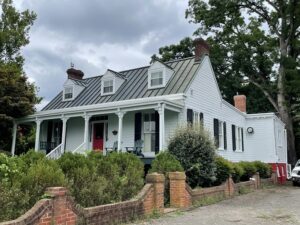
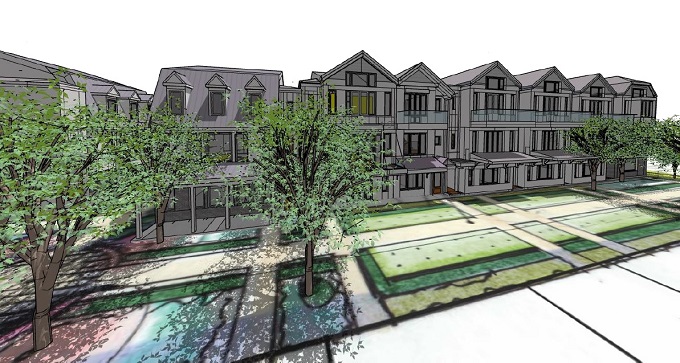


If the end product is anything like the renderings this looks like a very nice little infill.
looks like a nice project, I’m glad they were able to save the old house
Imagine how much more housing we would have if projects like this were ‘by-right’ and not an exception to the zoning. Blurb in Axios the other day lamented the ‘tear down – rebuild’ of legacy housing in this area with newer single family detached units. Well thats what our zoning incentivises and – incentives matter. It takes a unique developer like Center Creek to go against the grain to provide something denser and they must do so for a price. We can change that – whose running for the 1st district that supports liberating zoning controls so we get more… Read more »
The Axios article also talked about, and was focused on, the demo rebuild putting up McMansions at the expense of starter size and lower priced homes. Yes good they are saving the historic farm house but if this was by “by right” everywhere in the city what evidence do you have that builders would do affordable infill homes without incentives?? Study after study shows up-zoning increases density but rarely helps with affordability. We need more affordable not more $600k infill units! But this is a good project; love the courtyard feel.
Adding the $600K infill units means those buyers are not bidding up prices elsewhere. Allowing this by right means the cost of getting permission is reduced too, the pool of small developers and individual property owners who could add units on property they own would expand. All the layers of regulation add to the cost and therefore the end price to buyer. What we have now is that the by right option is to replace a modest single family home with a HUGE single family home does nothing to approve affordability or add more housing units where people want to… Read more »
actually the studies show quite clearly that upzoning and infill helps with affordability, not sure where you got that from. Look at Austin for recent data
Austin has net negative migration. Improving affordability is not due to infill, it’s due to decreased demand all over Austin.
It’s wonderful that they’ve decided to save the old farm house and incorporate it into the development.
Infill Schminfill. Of course! Let’s take RVA infrastructure and a sewer system that’s ready to fail completely, and pack in hundreds of additional residences and apartments without any regard to what the system can handle. Or needs.
Yes, let’s. It’s cheaper and more sustainable to build here and take advantage of existing infrastructure while upgrading what we have versus continuing to build out and out. These are exactly the type of projects we need.
The struggle is real. More and more NoVAians are moving to RVA and finding that, despite their substantial income advantage, they are still unable to purchase homes within walking distance of restaurants and coffee shops. We must help these downtrodden people.
Cheaper, as in affordable? Or cheaper, as in more profitable? You really don’t get it.
the systems can easily handle this. It’s a city, not a rural area. The sewer issues are not related
And cities are where houseing is supposed to be built.
Tell the thousands that were heavily inconvenienced by sewer work on Cary St. recently that sewer issues are not related.
If you live around this area of Grove and Hamilton than you’d know how bad the sewer system is. We’re constantly getting backed up when it storms and the area smells of methane
It would be nice if there was just one driveway for the development going straight on to Lafayette. A pity to dump it all on to Grove next to that hill.
Center Creek met with people in the Henry Place neighborhood, who strongly encouraged them to do Grove Ave access. Reveille/Sterling/Lafayette is a narrow, curvy road where cars on corners are often sideswiped. We are grateful that they listened.
Am I the only person that thinks infill should be scaled to the existing neighborhood building dimensions? What is the upside of shoehorning 14 attached homes within the footprint designed for 3 single family homes? Except for the profits of the developer. Why not tear down 2 more existing homes and replace with 8 townhomes if the proportions are the same? I would be furious if I lived on this block.
Maybe that 14 people get to live in a great location close to walkable amenities rather than 3 people? Gosh how awful of the big bad developers. Housing is so expensive because of people like you who complain about any new housing stock being built.
this is a great project, neighborhoods in the city should be dense. People who want to live in Hanover should go live in Hanover, and stop trying to make the city more like Hanover.
Cities should be allowed to be cities. It’s good for them. And good for those of us who like living in cities. I drive by this regularly and I don’t think it will affect the area at all, except for in good ways.
That’s a fine argument – and logical – if we were starting from scratch. The original commenter’s point – which the 1st response opted to treat with the unneighborly invective that’s has taken over public discourse – is that this isn’t a question of whether new folks coming into the neighborhood should choose Hanover or malvern manors. It’s that people are already residing in the neighborhood long before these infills. I’ve lived in the area more on than off for the last 30 years and have seen these changes . Are people guaranteed for there to be no nearby or… Read more »
I attended the first community meeting hosted by the developer at the property. I have nothing against them, they are fulfilling their mission by looking for maximum profit, but it’s worth noting their initial concept included the demolition of the historic house and all new entrances from the rear on Sterling. This revision is the result of meaningful engagement with the neighbors. Unfortunately, our SUP process only requires those within 150′ to be notified, and this area doesn’t have a civic association. Funny nuance there, as Westhampton Civic Association did attend, which upset the long-time residents (why would a developer… Read more »
I also thought it was very odd, that Westhampton Civic Association was ‘involved’ at all. Entirely different areas. It would be similar if the 3900 block of Grove was asked to represent all the changes to Westhampton, vs the residents.
They cover a huge area, from Patterson Ave. to the James River. A lot of it seems to be the city planning treated them a backup for areas like this one where there’s no other group–which their President said at the meeting. But I’m not sure that helps in the review process when their feedback drowns out the feedback from the actual residents or is treated by the planning commission as more informed/professional. Check out their “neighborhoods we serve” to get an idea of just how disruptive that can be: https://www.westhamptoncitizensassociation.com/page-18187 Also, I’d note very few developers are benevolent. I… Read more »
I think you answered why WCA was there – that area doesn’t have an address specific group and the Westhampton area has been dealing with similar issues of small houses being torn down and replaced with behemoth condo buildings (Libbie, Granite, etc)